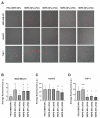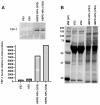Macromolecules Absorbed from Influenza Infection-Based Sera Modulate the Cellular Uptake of Polymeric Nanoparticles
- PMID: 36546919
- PMCID: PMC9775140
- DOI: 10.3390/biomimetics7040219
Macromolecules Absorbed from Influenza Infection-Based Sera Modulate the Cellular Uptake of Polymeric Nanoparticles
Abstract
Optimizing the biological identity of nanoparticles (NPs) for efficient tumor uptake remains challenging. The controlled formation of a protein corona on NPs through protein absorption from biofluids could favor a biological identity that enables tumor accumulation. To increase the diversity of proteins absorbed by NPs, sera derived from Influenza A virus (IAV)-infected mice were used to pre-coat NPs formed using a hyperbranched polyester polymer (HBPE-NPs). HBPE-NPs, encapsulating a tracking dye or cancer drug, were treated with sera from days 3-6 of IAV infection (VS3-6), and uptake of HBPE-NPs by breast cancer cells was examined. Cancer cells demonstrated better uptake of HBPE-NPs pre-treated with VS3-6 over polyethylene glycol (PEG)-HBPE-NPs, a standard NP surface modification. The uptake of VS5 pre-treated HBPE-NPs by monocytic cells (THP-1) was decreased over PEG-HBPE-NPs. VS5-treated HBPE-NPs delivered a cancer drug more efficiently and displayed better in vivo distribution over controls, remaining stable even after interacting with endothelial cells. Using a proteomics approach, proteins absorbed from sera-treated HBPE-NPs were identified, such as thrombospondin-1 (TSP-1), that could bind multiple cancer cell receptors. Our findings indicate that serum collected during an immune response to infection is a rich source of macromolecules that are absorbed by NPs and modulate their biological identity, achieving rationally designed uptake by targeted cell types.
Keywords: drug delivery; nanomedicine; paclitaxel; protein corona; tumor.
Conflict of interest statement
ARK is a shareholder in Seva Therapeutics, Inc. No competing interests are among the other authors.
Figures






Similar articles
-
Polymeric Nanoparticles with a Sera-Derived Coating for Efficient Cancer Cell Uptake and Killing.ACS Omega. 2021 Feb 19;6(8):5591-5606. doi: 10.1021/acsomega.0c05998. eCollection 2021 Mar 2. ACS Omega. 2021. PMID: 33681599 Free PMC article.
-
Preparation and Biosafety Assessment of Water-Soluble Hyperbranched Polyester Nanoparticles with Carboxylic Acid Functional Groups.J Nanosci Nanotechnol. 2015 Jan;15(1):138-43. doi: 10.1166/jnn.2015.8770. J Nanosci Nanotechnol. 2015. PMID: 26328318
-
Design and Synthesis of New Sulfur-Containing Hyperbranched Polymer and Theranostic Nanomaterials for Bimodal Imaging and Treatment of Cancer.ACS Macro Lett. 2017 Mar 21;6(3):235-240. doi: 10.1021/acsmacrolett.7b00008. Epub 2017 Feb 20. ACS Macro Lett. 2017. PMID: 29104818 Free PMC article.
-
Understanding the Factors Influencing Chitosan-Based Nanoparticles-Protein Corona Interaction and Drug Delivery Applications.Molecules. 2020 Oct 16;25(20):4758. doi: 10.3390/molecules25204758. Molecules. 2020. PMID: 33081296 Free PMC article. Review.
-
The interaction between nanoparticles-protein corona complex and cells and its toxic effect on cells.Chemosphere. 2020 Apr;245:125624. doi: 10.1016/j.chemosphere.2019.125624. Epub 2019 Dec 12. Chemosphere. 2020. PMID: 31864050 Review.
Cited by
-
Biomembrane-wrapped gene delivery nanoparticles for cancer therapy.Front Bioeng Biotechnol. 2023 Jun 7;11:1211753. doi: 10.3389/fbioe.2023.1211753. eCollection 2023. Front Bioeng Biotechnol. 2023. PMID: 37351470 Free PMC article. Review.
-
Discovering nanoparticle corona ligands for liver macrophage capture.Nat Nanotechnol. 2025 Jul;20(7):914-925. doi: 10.1038/s41565-025-01903-6. Epub 2025 May 15. Nat Nanotechnol. 2025. PMID: 40374797
References
-
- Madathiparambil Visalakshan R., Gonzalez Garcia L.E., Benzigar M.R., Ghazaryan A., Simon J., Mierczynska-Vasilev A., Michl T.D., Vinu A., Mailander V., Morsbach S., et al. The Influence of Nanoparticle Shape on Protein Corona Formation. Small. 2020;16:e2000285. doi: 10.1002/smll.202000285. - DOI - PubMed
-
- Gref R., Luck M., Quellec P., Marchand M., Dellacherie E., Harnisch S., Blunk T., Muller R.H. ‘Stealth’ corona-core nanoparticles surface modified by polyethylene glycol (PEG): Influences of the corona (PEG chain length and surface density) and of the core composition on phagocytic uptake and plasma protein adsorption. Colloids Surf. B Biointerfaces. 2000;18:301–313. doi: 10.1016/S0927-7765(99)00156-3. - DOI - PubMed
Grants and funding
LinkOut - more resources
Full Text Sources
Miscellaneous

